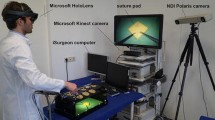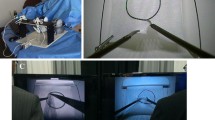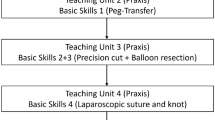Abstract
Background
There is a large and growing gap between the need for better surgical training methodologies and the systems currently available for such training. In an effort to bridge this gap and overcome the disadvantages of the training simulators now in use, we developed the Computer-Enhanced Laparoscopic Training System (CELTS).
Methods
CELTS is a computer-based system capable of tracking the motion of laparoscopic instruments and providing feedback about performance in real time. CELTS consists of a mechanical interface, a customizable set of tasks, and an Internet-based software interface. The special cognitive and psychomotor skills a laparoscopic surgeon should master were explicitly defined and transformed into quantitative metrics based on kinematics analysis theory. A single global standardized and task-independent scoring system utilizing a z-score statistic was developed. Validation exercises were performed.
Results
The scoring system clearly revealed a gap between experts and trainees, irrespective of the task performed; none of the trainees obtained a score above the threshold that distinguishes the two groups. Moreover, CELTS provided educational feedback by identifying the key factors that contributed to the overall score. Among the defined metrics, depth perception, smoothness of motion, instrument orientation, and the outcome of the task are major indicators of performance and key parameters that distinguish experts from trainees. Time and path length alone, which are the most commonly used metrics in currently available systems, are not considered good indicators of performance.
Conclusion
CELTS is a novel and standardized skills trainer that combines the advantages of computer simulation with the features of the traditional and popular training boxes. CELTS can easily be used with a wide array of tasks and ensures comparability across different training conditions. This report further shows that a set of appropriate and clinically relevant performance metrics can be defined and a standardized scoring system can be designed.






Similar content being viewed by others
References
Accreditation Council for Graduate Medical Education (ACGME) Outcome Project. Available online at: http://www.acgme.org/outcome/
S Cotin N Stylopoulos M Ottensmeyer P Neumann D Rattner S Dawson (2002) Metrics for laparoscopic skills trainers: the weakest link! T Dohi R Kikinis (Eds) Lecture notes in computer science; vol 2488. Springer-Verlag Berlin 35–43
AM Derossis GM Fried M Abrahamowicz HH Sigman JS Barkun JL Meakins (1998) ArticleTitleDevelopment of a model for training and evaluation of laparoscopic skills. Am J Surg 175 482–487 Occurrence Handle10.1016/S0002-9610(98)00080-4 Occurrence Handle1:STN:280:DyaK1czgslOjuw%3D%3D Occurrence Handle9645777
Healy GB, Shore A, Meglan D, Russel M, Satava R (2002) The use of simulators in surgical education. Final report to the Board of Regents of the American College of Surgeons. Working Conference, Boston College, Chestnut Hill, MA, USA, 19–21 April 2002
LT Kohn JM Corrigan MF Donaldson (Eds) (1999) To err is human: building a safer health system. Institute of Medicine, National Academy Press Washington (DC)
Metrics for Objective Assessment of Surgical Skills Workshop, Scottsdale, AZ, USA, 9–10 July 2001. Final report. Available online at: http://www.tatrc.org
MySQL database. Available online at: http://www.mysql.com
JC Rosser LE Rosser RS Savalgi (1997) ArticleTitleSkill acquisition and assessment for laparoscopic surgery. Arch Surg 132 200–204 Occurrence Handle1:STN:280:ByiC1MvkvV0%3D Occurrence Handle9041927
NE Seymour AG Gallagher SA Roman MK O’Brien VK Bansal DK Andersen RM Satava (2002) ArticleTitleVirtual reality training improves operating room performance: results of a randomized double-blinded study Ann Surg 236 458–464 Occurrence Handle10.1097/00000658-200210000-00008 Occurrence Handle12368674
InstitutionalAuthorNameUnited States Surgical Corporation (USSC) Surgical Skills Training Center (2000) Report on the analysis and validation of the FLS examination. SAGES: Fundamentals of Laparoscopic Surgery (FLS) Project. Society of American Gastrointestinal Endoscopic Surgeons Santa Monica (CA) 1–20
Author information
Authors and Affiliations
Corresponding author
Rights and permissions
About this article
Cite this article
Stylopoulos, N., Cotin, S., Maithel, S. et al. Computer-enhanced laparoscopic training system (CELTS): bridging the gap. Surg Endosc 18, 782–789 (2004). https://doi.org/10.1007/s00464-003-8932-0
Received:
Accepted:
Published:
Issue Date:
DOI: https://doi.org/10.1007/s00464-003-8932-0




